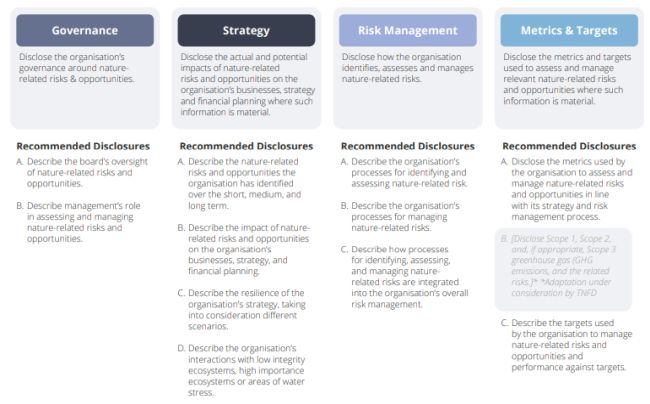- within Compliance topic(s)
- with Inhouse Counsel
- with readers working within the Accounting & Consultancy, Consumer Industries and Technology industries
The Taskforce on Nature-Related Financial Disclosures (TNFD) has published the first draft of its Nature-related Risk & Opportunity Management and Disclosure Framework (TNFD Framework); which, together with subsequent drafts, will be open to feedback from market participants for the next 18 months. The TNFD is aiming to publish a usable framework and set of recommendations in late 2023.
The TNFD was set up to develop and deliver a risk management and disclosure framework for organisations to report and act on evolving nature-related risks. The TNFD notes that at present more than half of the global economy is highly or moderately dependent on nature, and that nature-related risks and opportunities should therefore be adequately accounted for in business and investment decisions.
The TNFD Framework builds upon the approach taken by the Taskforce on Climate-related Financial Disclosures (TCFD) and aims to provide recommendations and guidance on nature-related risks and opportunities. Notably, the TNFD Framework seeks to align itself with the developing global baseline for sustainability standards currently under development by the International Sustainability Standards Board (ISSB).
In July 2021, Chancellor of the Exchequer Rishi Sunak announced plans to introduce new Sustainability Disclosure Requirements (SDRs) in the UK. It is unclear at present if the TNFD recommendations when finalised would form part of these SDRs or how closely they will align with the ISSB baseline. For more information on the proposed SDRs see our blog post here.
The current draft TNFD Framework introduces three core components to nature-related disclosures:
- An outline of the fundamental concepts and approach to what nature is in the context of nature-related risk and opportunity disclosure;
- draft disclosure recommendations for nature-related risks and opportunities; and
- guidance for undertaking nature-related risk and opportunity assessments.
Fundamental concepts and approach to nature
One of the core concepts from the draft TNFD Framework is the introduction of nature-related definitions. In a similar way to climate terminology becoming part of everyday business language, the TNFD believes an equivalent system is needed for nature-related language. Given the complicated interconnectivity of different ecosystems and climate change with nature, the TNFD has detailed their basic concepts in detail.
Nature itself is defined by reference to four "realms" - Land, Ocean, Freshwater and Atmosphere - which are in turn divided into biomes, assets and services. These are intended to provide an entry point for businesses to assess how they interact with nature across the globe. The TNFD then defines "nature capital" in a similar way to financial capital; natural resources that combine to yield a flow of benefits to people.
From a basic standpoint, the framework asks a business to assess how it interacts with nature across different biomes - noting any dependencies it has from nature - and the impacts (direct, indirect and cumulative) that stem from its activities. Location is outlined as being key to this concept as the same biome may come with different risks or opportunities depending on where it is globally.
Draft disclosure recommendations
The second component of the draft TNFD Framework is the TNFD's draft recommended disclosures for nature-related risk and opportunity reporting. These disclosures follow the TCFD's four pillars of disclosure: governance, strategy, risk management and metrics and targets and are outlined below.

The draft recommended disclosures include four general requirements that all disclosures should be based on, these are: an assessment of nature-related dependencies and impacts, consideration of location, consideration of capabilities of nature-related risk and opportunity assessment and management, and a statement of the scope of disclosures and what will be covered in future disclosures.
Guidance for undertaking nature-related risk and opportunity assessments
The final component outlined in the draft TNFD Framework is a nature-related risk and opportunity assessment approach. The TNFD has included this based on current feedback received and intends for it to be a practical guide for organisations to incorporate nature considerations into their risk management processes.
The TNFD's first version of this integrated assessment process is called LEAP (Locate, Evaluate, Assess, Prepare) and aims to support nature-related reporting. Briefly, the process works in four phases, and requires organisations to locate their interface with nature, evaluate their dependencies and impacts with nature, assess their risks and opportunities stemming from nature, and prepare to respond to nature-related risks and opportunities.
The draft TNFD Framework currently published is a very early draft but provides a key indication of what nature-related disclosures may look like in the future. The TNFD intends to publish multiple further drafts over the next 18 months expanding on certain areas including the link between nature and climate, social dimensions to nature-related reporting and introducing sector-specific guidance.
The content of this article is intended to provide a general guide to the subject matter. Specialist advice should be sought about your specific circumstances.



